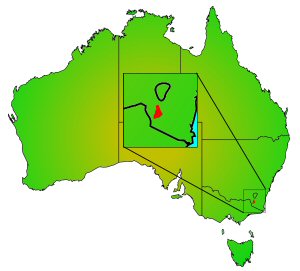Kosciuszko galaxias facts for kids
Quick facts for kids Kosciuszko galaxias |
|
|---|---|
| Conservation status | |
|
Critically Endangered (ASFB)
|
|
| Scientific classification | |
| Genus: |
Galaxias
|
| Species: |
supremus
|
The Kosciuszko galaxias (scientific name: Galaxias supremus) is a type of freshwater fish. It belongs to a group of fish called galaxiids. This fish is part of the Galaxias genus and is found in Australia. It is also a member of the "Mountain Galaxias" group of fish.
Contents
About the Kosciuszko Galaxias
The Kosciuszko galaxias looks a lot like other fish in its family. It has a mouth that sits low on its long nose. Its back fin (dorsal fin), belly fins (pelvic fins), and bottom fin (anal fin) are placed far back on its body.
The part of its body just before the tail, called the caudal peduncle, is short and not very deep. Its tail fin is quite long, about 20% longer than this section. The dorsal and anal fins are short. The anal fin is set very far back, further than in other fish of its group.
Size and Appearance
The longest Kosciuszko galaxias ever found was about 96 millimetres (3.8 in) long. Most of them are usually around 80–85 millimetres (3.1–3.3 in) long.
This fish is light brown to tan on its head and body. It gets lighter below its side line, and its belly is even lighter. It has darker, uneven blotches all over its body. These blotches often join together to form irregular bands. Sometimes, there are also many tiny, dark grey spots.
Occasionally, you might see very small black bars mixed with the blotches and spots around the middle of its body. Its gill covers are light brown with a medium-sized gold patch. The fish has small eyes with a golden center. Sometimes, a thin band of gold spots can be seen on its upper back, between its neck and back fin. Its head has scattered gold flecks. From behind its front fins to its tail, there is a band of gold to coppery spots. These spots are mostly found below its side line and towards the back of the fish.
Where the Kosciuszko Galaxias Lives
This fish is not found in many places. It has only been seen in Blue Lake and a stream called Carruthers Creek. These places are at the top of the Snowy River system. They are located on Mount Kosciuszko in New South Wales, Australia. The fish live at a high elevation, between 1,900–1,950 metres (6,230–6,400 ft) above sea level.
We don't know how much its living area has changed over time. However, other types of fish, like alien trout, live in the upper parts of the Snowy River. These trout are very close, within 2 kilometres (6,600 ft) of the Blue Lake. Scientists believe these trout might be stopping the Kosciuszko galaxias from spreading to new areas.
Habitat
The Kosciuszko galaxias lives in very cold water. It can be found in small, clear streams and in Blue Lake. The streams where it lives are usually 0.6–1.1 metres (2.0–3.6 ft) wide and 50–60 centimetres (20–24 in) deep. The bottom of these streams can be bedrock, large rocks, gravel, or sand. The lake bed has pebbles, gravel, and silt.
This fish can handle very cold water, even below 2 °C (36 °F), for long periods. During winter, these waters are covered with snow and ice for many months. Scientists have mostly found these fish in stream pools. They hide among rocks, under banks, and in overhanging grasses. In the lake, they were found near rocks and small stones within 2 metres (6.6 ft) of the shore. We don't know much about where the fish live in the deeper parts of the lake.
Lifecycle and Reproduction
The Kosciuszko galaxias lives only in freshwater. We don't know exactly when they lay their eggs, but it is probably in late spring to early summer. Adult fish caught in mid-March had eggs that were starting to develop.
Conservation
The Kosciuszko galaxias is considered critically endangered. This means it is at a very high risk of becoming extinct in the wild.
Utility to Humans
People do not fish for the Kosciuszko galaxias. This is because it is a small fish and it is critically endangered, so it needs to be protected.



